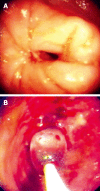Long-term results of endoscopic balloon dilatation of lower gastrointestinal tract strictures in Crohn's disease: a prospective study
- PMID: 19496192
- PMCID: PMC2691493
- DOI: 10.3748/wjg.15.2623
Long-term results of endoscopic balloon dilatation of lower gastrointestinal tract strictures in Crohn's disease: a prospective study
Abstract
Aim: To examine the long-term results of endoscopic treatment in a prospective study conducted over a period of 10 years, 1997 to January 2007.
Methods: A total of 25 patients (20 female and five male: aged 18-75 years), with at least one symptom of stricture not passable with the standard colonoscope and with a confirmed scarred Crohn's stricture of the lower gastrointestinal tract, were included in the study. The main symptom was abdominal pain. The endoscopic balloon dilatation was performed with an 18 mm balloon under endoscopic and radiological control.
Results: Eleven strictures were located in the colon, 13 at the anastomosis after ileocecal resection, three at the Bauhin valve and four in the ileum. Four patients had two strictures and one patient had three strictures. Of the 31 strictures, in 30 was balloon dilatation successful in a single endoscopic session, so that eventually the strictures could be passed easily with the standard colonoscope. In one patient with a long stricture of the ileum involving the Bauhin valve and an additional stricture of the ileum which were 15 cm apart, sufficient dilatation was not possible. This patient therefore required surgery. Improvement of abdominal symptoms was achieved in all cases which had technically successful balloon dilatation, although in one case perforation occurred after dilatation of a recurrent stricture. Available follow-up was in the range of 54-118 mo (mean of 81 mo). The relapse rate over this period was 46%, but 64% of relapsing strictures could be successfully dilated again. Only in four patients was surgery required during this follow-up period.
Conclusion: We conclude from these initial results that endoscopic balloon dilatation, especially for short strictures in Crohn's disease, can be performed with reliable success. Perforation is a rare complication. It is our opinion that in the long-term, the relapse rate is probably higher than after surgery, but usually a second endoscopic treatment can be performed successfully, leading to a considerable success rate of the endoscopic procedure.
Figures



Similar articles
-
Short and long-term outcomes of endoscopic balloon dilatation for Crohn's disease strictures.World J Gastroenterol. 2013 Jan 7;19(1):86-91. doi: 10.3748/wjg.v19.i1.86. World J Gastroenterol. 2013. PMID: 23326167 Free PMC article.
-
Efficacy and safety of endoscopic balloon dilation of symptomatic upper and lower gastrointestinal Crohn's disease strictures.J Clin Gastroenterol. 2005 Apr;39(4):284-90. doi: 10.1097/01.mcg.0000155128.31208.44. J Clin Gastroenterol. 2005. PMID: 15758621
-
Fecal marker levels as predictors of need for endoscopic balloon dilation in Crohn's disease patients with anastomotic strictures.World J Gastroenterol. 2017 Sep 21;23(35):6482-6490. doi: 10.3748/wjg.v23.i35.6482. World J Gastroenterol. 2017. PMID: 29085198 Free PMC article.
-
Endoscopic Balloon Dilatation in the Treatment of Benign Ureteral Strictures: A Meta-Analysis and Systematic Review.J Endourol. 2019 Apr;33(4):255-262. doi: 10.1089/end.2018.0797. Epub 2019 Feb 7. J Endourol. 2019. PMID: 30628477
-
Endoscopic balloon dilatation of postsurgical intestinal strictures in Crohn's disease: case report and review of the literature.Acta Clin Croat. 2013 Sep;52(3):374-9. Acta Clin Croat. 2013. PMID: 24558771 Review.
Cited by
-
Mechanisms, Management, and Treatment of Fibrosis in Patients With Inflammatory Bowel Diseases.Gastroenterology. 2017 Feb;152(2):340-350.e6. doi: 10.1053/j.gastro.2016.09.047. Epub 2016 Oct 5. Gastroenterology. 2017. PMID: 27720839 Free PMC article. Review.
-
Creation of a neopylorus after pyloric exclusion using a "double-endoscope" technique.Surg Endosc. 2016 Jul;30(7):3133-7. doi: 10.1007/s00464-015-4573-3. Epub 2015 Oct 20. Surg Endosc. 2016. PMID: 26487238
-
Endoscopic balloon dilatation of Crohn's-associated intestinal strictures: High patient satisfaction and long-term efficacy.United European Gastroenterol J. 2016 Dec;4(6):794-799. doi: 10.1177/2050640616628515. Epub 2016 Jan 19. United European Gastroenterol J. 2016. PMID: 28408997 Free PMC article.
-
Comparison of strictureplasty and endoscopic balloon dilatation for stricturing Crohn's disease--review of the literature.Int J Colorectal Dis. 2010 Oct;25(10):1149-57. doi: 10.1007/s00384-010-1010-x. Epub 2010 Jul 14. Int J Colorectal Dis. 2010. PMID: 20628881 Review.
-
The gates of hell: Crohn's disease isolated to the pylorus and ileo-cecal valve.Dig Dis Sci. 2014 Jun;59(6):1108-11. doi: 10.1007/s10620-014-3066-x. Epub 2014 Feb 19. Dig Dis Sci. 2014. PMID: 24549833 No abstract available.
References
-
- Alexander-Williams J, Haynes IG. Conservative operations for Crohn‘s disease of the small bowel. World J Surg. 1985;9:945–951. - PubMed
-
- Legnani PE, Kornbluth A. Therapeutic options in the management of strictures in Crohn’s disease. Gastrointest Endosc Clin N Am. 2002;12:589–603. - PubMed
-
- Tichansky D, Cagir B, Yoo E, Marcus SM, Fry RD. Strictureplasty for Crohn's disease: meta-analysis. Dis Colon Rectum. 2000;43:911–919. - PubMed
-
- Blomberg B, Rolny P, Jarnerot G. Endoscopic treatment of anastomotic strictures in Crohn's disease. Endoscopy. 1991;23:195–198. - PubMed
MeSH terms
LinkOut - more resources
Full Text Sources
Medical

